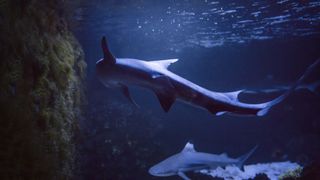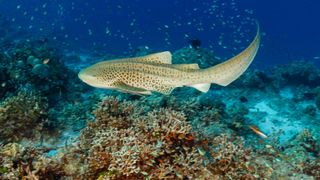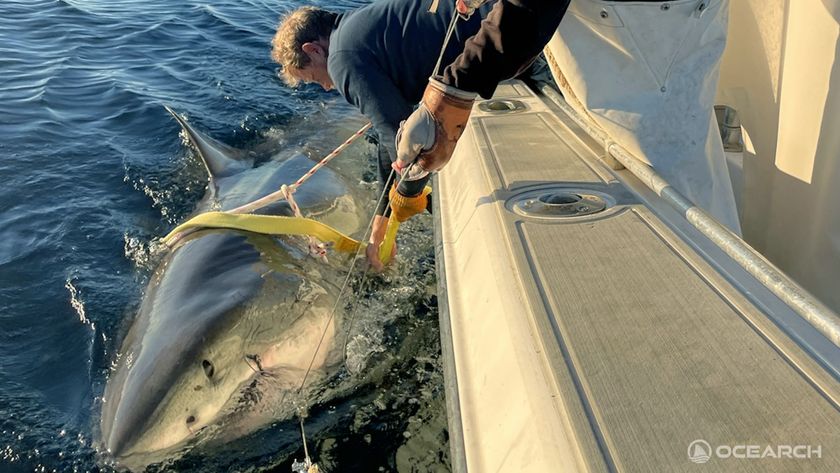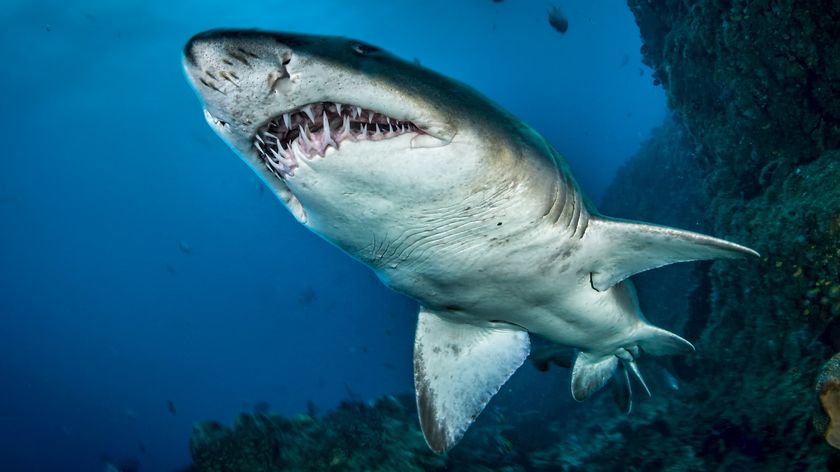Italian shark has 'virgin birth' after 10 years in all-female shark tank
The baby shark was born in an all-female tank with no father in sight.

A shark's rare "virgin birth" in an Italian aquarium may be the first of its kind, scientists say.
The female baby smoothhound shark (Mustelus mustelus) — known as Ispera, or "hope" in Maltese — was recently born at the Cala Gonone Aquarium in Sardinia to a mother that has spent the past decade sharing a tank with one other female and no males, Newsweek reported.
This rare phenomenon, known as parthenogenesis, is the result of females' ability to self-fertilize their own eggs in extreme scenarios. Parthenogenesis has been observed in more than 80 vertebrate species — including sharks, fish and reptiles — but this may be the first documented occurrence in a smoothhound shark, according to Newsweek.
Related: Hail Mary! 9 amazing tales of virgin births in the animal kingdom
"It has been documented in quite a few species of sharks and rays now," Demian Chapman, director of the sharks and rays conservation program at Mote Marine Laboratory & Aquarium in Florida, told Live Science. "But it is difficult to detect in the wild, so we really only know about it from captive animals," said Chapman, who has led several studies on shark parthenogenesis.
Virgin birth
Parthenogenesis may occur infrequently, but it happens in many types of sharks.
"About 15 species of sharks and rays are known to do this," Chapman said. But it is likely that most species can probably do it, he added.
Sign up for the Live Science daily newsletter now
Get the world’s most fascinating discoveries delivered straight to your inbox.
Scientists notice parthenogenesis occurring most often in carpet sharks, particularly white-spotted bamboo sharks (Chiloscyllium plagiosum) and zebra sharks (Stegostoma tigrinum), because they are common aquarium species. However, parthenogenesis occurs in both oviparous (egg-laying) sharks, like carpet sharks, and viviparous (live-birthing) sharks, like smoothhound sharks, Chapman said.

In the wild, parthenogenesis may be a last resort for females that cannot find a mate, either because they have been separated from others in their species or because human impacts, such as climate change and overfishing, or natural selection pressures, such as predation and disease, have wiped out all the available males. In aquariums, separation from males or long periods of isolation can trigger this natural response in females, Chapman said.
Some individual sharks have been observed repeatedly giving birth via parthenogenesis over a period of years, and others may switch between parthenogenesis and sexual reproduction when introduced to a mate, Chapman said.
Imperfect cloning
There are two types of parthenogenesis: apomixis, a form of cloning common among plants, and automixis, a form of self-fertilization that more closely resembles sexual reproduction, according to National Geographic.
"Rather than combining with a sperm cell to make an embryo, [the egg cell] combines with a polar body, which is essentially another cell that is produced at the same time that the egg cell is produced and has the complementary DNA," Christine Dudgeon, a biosciences researcher at the University of Queensland in Australia who has studied shark parthenogenesis, told Live Science. In this scenario, the polar body acts as a pseudo-sperm cell with a single strand of DNA.
The resulting offspring get 100% of their their DNA from their mother but are not exact clones of them, Dudgeon said.
This is because sex cells, also known as gametes, have a unique combination of genes that are randomly selected from each parent as they are created — so each shark egg (or polar body) has a different genetic makeup. When the polar body and egg combine, they produce a baby shark that is genetically different from the mother. But because they are only made from one gamete , not two, parthenogenetic offspring are more closely related to their mother than normal babies are, Dudgeon said.
Because parthenogenesis in sharks happens only in females and females cannot pass on a Y chromosome, it also means the resulting offspring are always female. "The mother is XX, and so she will only pass on X chromosomes to the offspring," Dudgeon said.
Related: Sharks lay eggs. Here's some creepy footage of what that looks like.
Health issues
"Parthenogenesis is essentially a form of inbreeding, as the genetic diversity of the offspring is greatly reduced," Dudgeon said.
As such, offspring produced by parthenogenesis may have a reduced chance of survival, Dudgeon added.
"There is a high rate of embryonic failure among parthenogenetic offspring," Chapman said. "But when they do survive, many have normal lives, and some can even reproduce."
However, it is hard to pin down exactly why baby sharks die, whether they are parthenogenetic or not.
"Mortality in young sharks in aquaria, and the wild, is common, so it's hard to say what is causing it," Dudgeon said. "The [normal] offspring that are born have already won the lottery," she added.
Baby Ispera appears to be in good health and is expected to live a relatively normal life in captivity, according to Newsweek.
Originally published on Live Science.

Harry is a U.K.-based senior staff writer at Live Science. He studied marine biology at the University of Exeter before training to become a journalist. He covers a wide range of topics including space exploration, planetary science, space weather, climate change, animal behavior and paleontology. His recent work on the solar maximum won "best space submission" at the 2024 Aerospace Media Awards and was shortlisted in the "top scoop" category at the NCTJ Awards for Excellence in 2023. He also writes Live Science's weekly Earth from space series.
Most Popular




